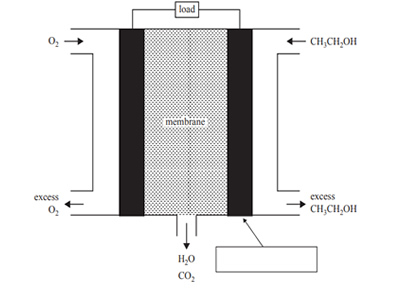1) Consider the following statements about galvanic cells and fuel cells.

Which one of the following sets of statements is correct for both galvanic cells and fuel cells?
A. statement numbers 2 and 3
B. statement numbers 1 and 4
C. statement numbers 2, 4 and 5
D. statement numbers 1, 3 and 5
Solution
2) Some car manufacturers are exploring the use of an acidic ethanol fuel cell to power vehicles. In this fuel cell, the ethanol at one electrode reacts with water that has been produced at the other electrode. A membrane is used to transport ions between the electrodes. A diagram of an acidic ethanol fuel cell is shown below.
 .
.
a) Identify the electrode as either the cathode or the anode in the box provided in the diagram above.
b) Write the half-equation for the reaction occurring at the anode.
c)
The combustion of ethanol and the combustion of octane release about the same amount of energy per mole of carbon dioxide produced. Identify two advantages of powering a vehicle using an ethanol fuel cell instead of an internal combustion engine powered by octane.
Solution

2) The zinc–cerium battery is a commercial rechargeable battery that comprises a series of cells. During recharging, the cells use energy from wind farms or solar cell panels. During discharging, energy is supplied to electric grids to power local factories and homes. The electrolytes are stored in separate storage tanks, and are pumped into and out of each cell when in use. A membrane separates the two electrodes that are immersed in 1 M methanesulfonic acid, CH3SO3H. A diagram representing a zinc–cerium cell is shown below
Experts have regarded the zinc–cerium cell as a hybrid of a fuel cell and a secondary cell. Why would this be the case?
Solution
